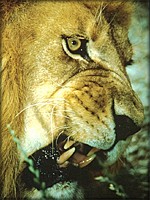 |
 |
HOMEPAGE |
 |
NEWS SUMMARY |
 |
U.S. |
 |
INTERNATIONAL |
 |
MONEYScope |
 |
WEATHER.com |
 |
LOCAL NEWS |
 |
ENTERTAINMENT |
 |
SPORTS |
 |
SCI / TECH |
 |
POLITICS |
 |
HEALTH |
 |
LIFESTYLES |
 |
TRAVEL |
 |
 |
|
|
| |
REFERENCE |
| |
TURBO NEWS |
| |
SEND
THIS PAGE
TO A FRIEND |
| |
EMAIL
ABCNEWS.com |
| |
HELP & TOOLS |
|
|
|
|
|
HOMEPAGE
 SCIENCE
SCIENCE
 FEATURE
FEATURE
|
|


Dental problems contributed to lion attacks on humans because humans are easy prey.
(ArtToday)
|
Man-Eating Lions Needed Dentists
Researchers Say Serious Dental Problems Drive Lions Wild
The Associated Press
D U R H A M, N.H., June 21
— Two lions that killed and ate 135 railway
workers in Kenya in 1898 may have suffered from extremely painful
toothaches that prevented them from attacking their normal prey,
researchers said.
|
|
|
A study of the lions’ jaws showed they suffered from problems
such as broken and badly turned teeth and abscesses that could have
made it difficult to take down large animals, researchers at
Chicago’s Field Museum said.
Over a nine-month period, workers building a railway bridge over
the Tsavo River in southeastern Kenya were dragged off and eaten by
the lions, which are now stuffed and on display at the museum.
Easy Prey
“Humans are easy prey. We’re very slow, we don’t hear very well
and we don’t see very well in the dark,” museum zoologist Bruce
Patterson said.
Patterson, who co-wrote the study with dentist and carnivore
expert Ellis Neiburger, was to present the findings on the two
Tsavo lions and a third man-eating lion Tuesday at the annual
meeting of the American Society of Mammologists at the University
of New Hampshire.
He said the findings coincide with an “infirmity theory” that
explains why wild lions and tigers sometimes hunt humans. Neiburger
said all three had severe dental and jaw problems that might have
made it too painful to bite down forcefully.
No Normal Diet
One Tsavo lion’s canine teeth were in such poor shape it would
have been difficult to take the “killing bite” through a small
animal’s spinal column or clamp the windpipe of a larger animal.
The other Tsavo lion had a chipped tooth that exposed pulp, and the
museum’s third lion, which killed six people in 1991 in Zambia, had
a chronic jaw infection — both conditions that probably would not
have prevented it from eating a normal diet, researchers said.
Patterson said researchers are “appropriately cautious” in
saying dental problems contributed to the lions’ attacks on humans.
He said factors such as lack of prey, other physical problems or a
“man-eating” culture could not be ruled out.
Patterson began examining the skulls when the story of the Kenya
attacks was being made into a 1996 movie, The Ghost and the
Darkness. 
|
|
Copyright 2000 The Associated Press. All rights reserved. This material may not be published, broadcast, rewritten or redistributed.
|
|
 |
|



